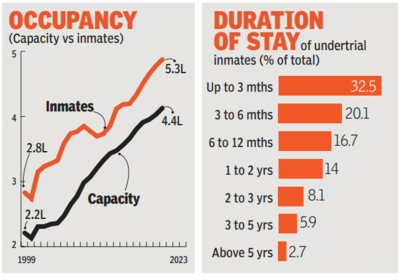Around three-fourth of all prison inmates in India in 2023 were undertrials , according to the latest report released by NCRB . The numbers are staggering: India has 5.3 lakh people in jail; of them, 3.9 lakh are yet to be convicted — they are on trial.
But this is actually an improvement over the previous years. The percentage of incarcerated undertrials in 2021 was 77%. This fell to 76% in 2022, and then to 74% in 2023.
Of these undertrials, 150 died while in jail; 64% of them were suicides.

The share of undertrials in jail keeps fluctuating, but an analysis of the data for the past 25 years shows it has never dropped below 65%. Several studies have suggested that delays in investigation, shortage of judges, and lack of access to legal aid because of poverty are the main reasons why undertrials end up spending a long time in prisons. There are 3.6 crore pending criminal cases in district courts, 17.5 lakh cases in high courts and 14,667 cases in the Supreme Court.

In answer to a Parliament question last Feb, it was revealed that the judge-to-population ratio in India is estimated at 21 judges per million population, which is less than half of what the Law Commission recommended in its 120th report.
With so many undertrials in jail, our prisons have also become overcrowded. Although the occupancy rate has improved from 131% in 2022 to 121% in 2023, jails have more inmates than their sanctioned capacity and this has been the case for the past 25 years. Twenty years ago, the situation was even worse as the occupancy rate had touched 145% in 2005. Since then, jails have been equipped to handle 1.9 lakh more prisoners, but that has clearly not been enough.
But this is actually an improvement over the previous years. The percentage of incarcerated undertrials in 2021 was 77%. This fell to 76% in 2022, and then to 74% in 2023.
Of these undertrials, 150 died while in jail; 64% of them were suicides.

The share of undertrials in jail keeps fluctuating, but an analysis of the data for the past 25 years shows it has never dropped below 65%. Several studies have suggested that delays in investigation, shortage of judges, and lack of access to legal aid because of poverty are the main reasons why undertrials end up spending a long time in prisons. There are 3.6 crore pending criminal cases in district courts, 17.5 lakh cases in high courts and 14,667 cases in the Supreme Court.
In answer to a Parliament question last Feb, it was revealed that the judge-to-population ratio in India is estimated at 21 judges per million population, which is less than half of what the Law Commission recommended in its 120th report.
With so many undertrials in jail, our prisons have also become overcrowded. Although the occupancy rate has improved from 131% in 2022 to 121% in 2023, jails have more inmates than their sanctioned capacity and this has been the case for the past 25 years. Twenty years ago, the situation was even worse as the occupancy rate had touched 145% in 2005. Since then, jails have been equipped to handle 1.9 lakh more prisoners, but that has clearly not been enough.
You may also like

CBI busts HPZ crypto fraud, arrests five in pan-India 'Operation Chakra-V'

Death toll in Philippine earthquake rises to 70, with 559 injuries

2-wheeler sales rise 9 pc in September on GST cut, festive demand

EFL footballer, 21, slapped with long ban and fine on his birthday after lodging 252 bets

Tech Tips: Transfer chats from WhatsApp to Arattai like this, work will be done in minutes..







